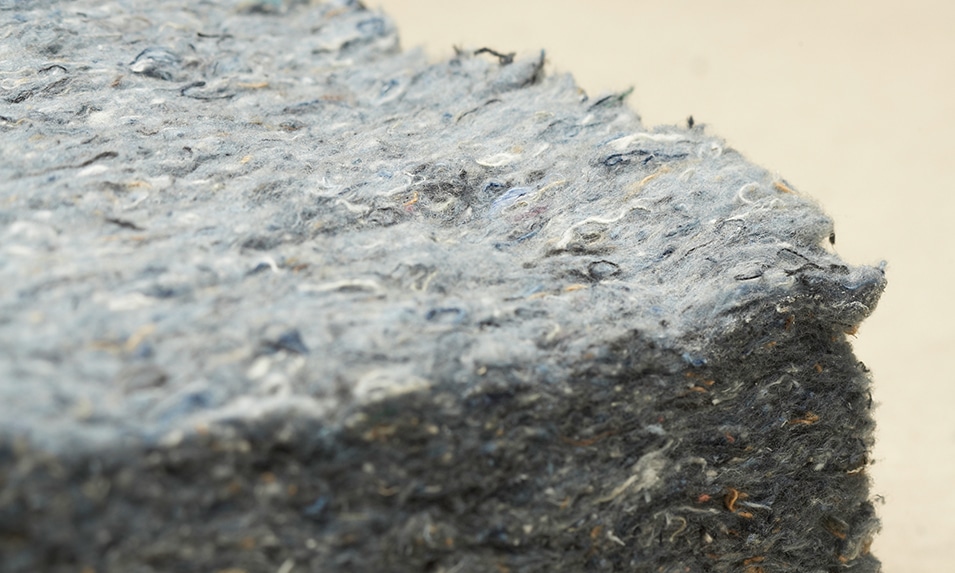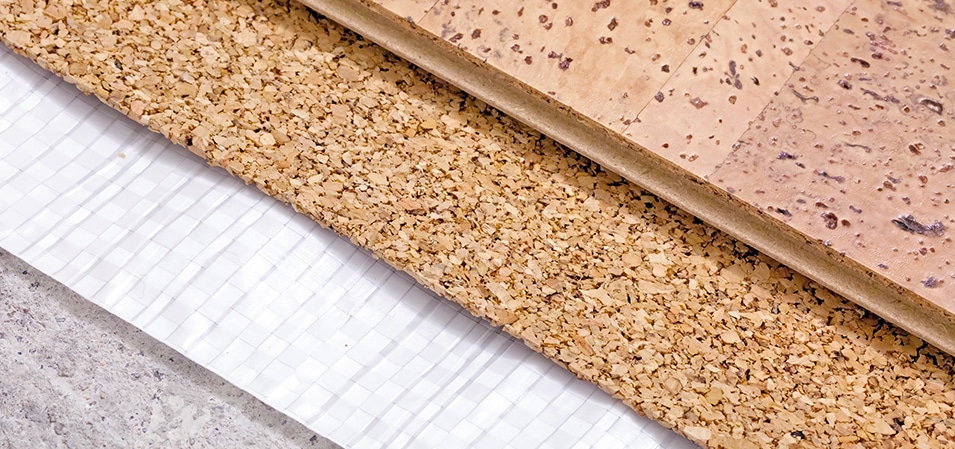Acoustic underlayment, explained
Flooring underlayment —the layer between the floor covering and the subfloor— adds value to commercial flooring systems in many ways. Underlay provides the cushion needed to reduce foot fatigue, the dimension stability needed to install flooring over minor subfloor imperfections and, in many cases, the high R-value necessary to contribute to a building’s thermal insulation.
But perhaps the most important design challenge underlayment solves is reducing the transmission of sound throughout a building. Architects and designers often use underlayment designed to dampen sounds —called acoustic underlayment— alongside acoustic ceiling and wall assemblies to soundproof buildings.
Below, we’ll explore how sound deadening underlayment can contribute to code compliance and how to choose the right acoustic underlayment for your application.

How acoustic underlayment contributes to building code compliance
National and local building codes establish strict acoustic requirements for student housing, apartment complexes, hotels and other building types where people might stay for extended periods of time. The goal of these codes is to reduce the noise exposure to those within the building, promoting their well-being.
While the codes regulate many types of noise —indoor noise levels, impact isolation, airborne noise— flooring primarily helps impact noise, or sound energy transmitting through the structural elements of your building from floor to floor.
The role of your flooring system in meeting acoustic requirements
Flooring system’s effectiveness at preventing impact noise transmission is measured by its Impact Insulation Class (IIC) — the higher a material’s IIC, the more effective it is at insulating impact noise. IIC is lab-tested by striking a flooring system with a “hammer machine” and measuring the sound heard in the floor below.
A flooring system not treated for impact sound isolation might have an IIC of 30. On the other side of the spectrum, a flooring system designed to promote acoustic performance might have an IIC of 70 or higher, according to Architectural Acoustics Illustrated.
The Uniform Building Code (UBC) requires floor and ceiling assemblies in multi-family housing to have an IIC of 50 or higher. But minimum codes are just that — minimum. Local codes in your area may call for a higher minimum IIC. And for luxury hotels, apartment buildings and condos, it may be wise to exceed these minimum codes to meet the expectations of a high-end buyer.
The cost of failing to meet noise requirements in multi-family housing
Owners, facility managers and architects alike would do well by paying attention to these codes: Failure to meet or beat the required STC and IIC ratings for your area could force building owner to rip up and replace their flooring system with one that does. And tenant noise complaints could potentially result in a lawsuit.
Architects put in quite a bit of legwork early on in the design process to ensure they specify a flooring system that will meet or exceed local codes. Acoustic underlayments (for hard surface flooring) and carpet cushions (for soft surface flooring) are key to achieving these strict codes.
They dampen sound by separating the floor covering and the subfloor with a thick, dense, insulative layer of felt, cork, rubber or another material, absorbing sound energy before it can reach the rooms below.
How to choose acoustic underlayment for your flooring material
The selection of flooring accessories —including underlayment’s, transition strips and adhesives— is almost always secondary to the selection of the flooring product itself. You wouldn’t, for instance, choose an acoustic underlayment and work backward from there.
Instead, you should take a holistic look at the needs of your application (aesthetics, high or low traffic, durability, acoustic needs) and choose the flooring material best-equipped to perform and provide value over its life cycle.
Once you choose a flooring material, you’ll follow the manufacturer’s recommendations for adhesives and underlayment so as not to void their warranty. Depending on the product you’re using, you might be able to choose between several of the manufacturer’s underlayment options offering different performance attributes such as improved moisture tolerance or sound absorption.
You can work with your flooring contractor to choose the acoustic flooring system —including the flooring itself, its underlayment and installation accessories— best tailored to the specific needs of your application.

A closer look at your acoustic underlay options
Here, we’re not only going to give broad guidelines of which acoustic underlay materials are most compatible with resilient and soft flooring, but also an example of a proprietary acoustic underlayment.
-
Acoustic carpet cushions
Although carpet tiles and broadlooms inherently absorb airborne noise and reduce floor-to-floor sound transmission, a dense foam or rubber carpet cushion can vastly improve its acoustic performance. CushionWorx®, a proprietary foam underlayment for compatible carpet tiles, boasts a potential IIC of up to 76 along with antimicrobial benefits and high moisture resistance.
-
Acoustic underlayment for tile
Tile flooring is often installed with what’s called the wet-set installation method due to the moisture present during installation — and as such, wood underlayment does not perform well under tile. Instead, rubber, foam or rubber-cork underlayment tends to be the best choice.AbsorbaSound™ is an example of a proprietary rubber underlayment which can, along with compatible tile flooring systems and sound deadening ceiling assemblies, achieve an IIC of 64.
-
Acoustic underlayment for wood
In applications where acoustics are a key consideration, it’s important to glue or float the flooring rather than nail — so sound energy can’t travel directly through the nail, into the subfloor and down into the rooms below.An acoustic underlayment made of cork, rubber or foam can further dampen noise and prevent sound transmission. Along with a system such as DriTac 8302, compatible wood flooring systems can test at an IIC of as high as 73.
-
Acoustic underlayment for vinyl flooring
Acoustic underlayment for vinyl flooring must have the dimensional stability to prevent indents and the thickness to absorb sound. Generally speaking, felt, cork or foam would make good acoustic underlayment options. Rubber, though it might work functionally, is known to stain vinyl and wouldn’t be recommended. Hush II —consisting of cork and foam— is a good example of a proprietary underlayment system designed for luxury vinyl tile (LVT). When paired with compatible resilient flooring products, this system can achieve anywhere from 50 to 70 IIC.
While far from an exhaustive list of your acoustic underlayment options, the above gives a good starting point for selecting an acoustic flooring system for your building. The flooring market is saturated with acoustic underlayment products for every flooring type. But it’s important not to choose a product solely for its sound dampening qualities. Look for an underlayment that is compatible with your floor covering, adhesive and subfloor covering while taking factors such as moisture resistance, performance and long-term value into account.
For more information on how to choose the best floor for your building, check out our guide to flooring products. It’ll guide you toward choosing better materials by teaching you what to consider in the selection process such as cost, durability, design and maintenance. Or, if you’d like one-on-one help choosing a flooring system for your facility, request a no-obligation consultation today.
Flooring solutions for cost, schedule and design
To get started with our complimentary consultation service, simply fill out the form.
